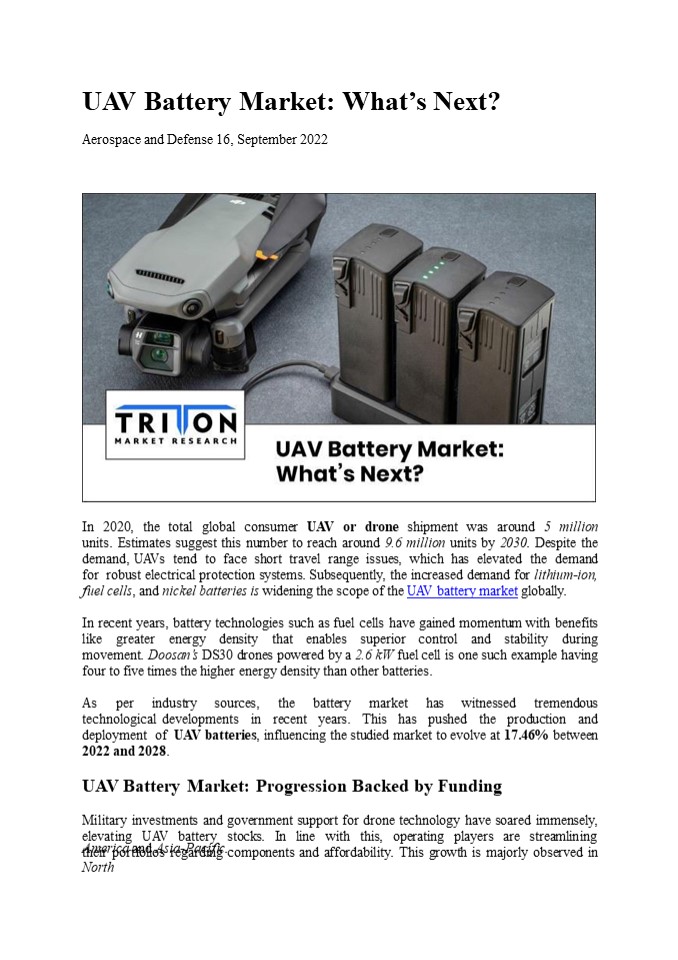UAV Battery Market: What’s Next? - PowerPoint PPT Presentation
Title:
UAV Battery Market: What’s Next?
Description:
The increased demand for lithium-ion, fuel cells, and nickel batteries is widening the scope of the UAV battery market globally. Read More about UAV Battery Market – PowerPoint PPT presentation
Number of Views:0
Title: UAV Battery Market: What’s Next?
1
UAV Battery Market Whats Next? Aerospace and
Defense 16, September 2022
In 2020, the total global consumer UAV or
drone shipment was around 5 million units.
Estimates suggest this number to reach around 9.6
million units by 2030. Despite the demand, UAVs
tend to face short travel range issues,
which has elevated the demand for robust
electrical protection systems. Subsequently, the
increased demand for lithium-ion, fuel cells, and
nickel batteries is widening the scope of the UAV
battery market globally. In recent years,
battery technologies such as fuel cells have
gained momentum with benefits like greater
energy density that enables superior control
and stability during movement. Doosans DS30
drones powered by a 2.6 kW fuel cell is one such
example having four to five times the higher
energy density than other batteries. As per
industry sources, the battery market
has witnessed tremendous technological
developments in recent years. This has
pushed the production and deployment of UAV
batteries, influencing the studied market to
evolve at 17.46 between 2022 and 2028. UAV
Battery Market Progression Backed by
Funding Military investments and government
support for drone technology have soared
immensely, elevating UAV battery stocks. In
line with this, operating players are
streamlining their portfolios regarding
components and affordability. This growth is
majorly observed in North
America and Asia-Pacific.
2
- The Asia-Pacific UAV battery market is expected
to witness the fastest growth at a CAGR of 18.01
due to rising investments in battery RD and
defense budgets, such as - China, for instance, invested 293 billion
in its 2021 defense budget, focusing
primarily on security surveillance,
fueling the deployment of unmanned aerial
vehicles. - The Indian government liberalized drone
rules by announcing a 100 subsidy for
using UAVs in the agricultural sector. - The Japanese government is developing an
autonomous combat drone to detect energy
aircraft and eliminate any missile strikes. This
development project is believed to be a joint
undertaking with the US, with a prototype set to
be ready for testing by 2025. - Such government measures have sored demand for
lithium-based batteries, which leads the market
in terms of product type. Their role in
supporting long cycle life and energy efficiency
in UAVs propels the segments growth. Hence,
companies like Shenzhen Grepow Battery are
launching high-technology lithium batteries to
gain a competitive edge in the market. - However, geographically, North America UAV
battery backs the highest position in 2021,
with a CAGR of 17.54. This growth is
attributable to increasing military funding, with
the United States accounting for a major share.
For instance - The US Department of Transportation FAA invested
2.7 million to support research on UAVs used in
disaster preparedness, creating a high demand for
Li-ion, fuel cells, etc. - The Federal government allocated around 7.5
billion to the Pentagon for the - employment of numerous robotic technologies,
including UAVs, for air, ground, maritime,
and other domains. - Transport Canada introduced a Drone Strategy to
2025 program to provide a strategic vision for
drones, raising awareness about their
significance and untapped economic potential that
will drive the sectors growth. - Industry-wise Outlook Surveillance Measures
Widens Scope - Commercial, consumer, and industry verticals
are key categories supporting the markets
growth. Among these, Defense, government,
law enforcement secures the majority of
shares in the industry vertical segment. The high
demand in the sector has guided companies like
Boeing to develop drones like MQ-25
Stingray aerial refueling. In 2021, the
drone completed carrier-based testing. And in
early 2022, it became the first drone to
refuel a Boeing F/A-18 Super Hornet. As
a result, prominent players like
General Atomics Aeronautical and
AeroVironment Inc have integrated new
technologies to develop high- endurance
batteries, thereby creating opportunities for the
UAV battery market. - Commercial Drones to Star with Augmented
Applications
like Amazon are fueling the adoption with the
launch of Prime Air Fixed-wing Drones for
3
- delivery purposes. Although the market is
projected to strengthen, it faces certain
challenges such as - Issues arise from a series of electrical
malfunctions mid-flight and other thermal
runaway complications. - Stringent regulations that are restricting the
transport of unmanned aerial vehicles. - Nevertheless, the ongoing expansion in
industries and capitalization from
geographies are projected to create prospects
for the UAV battery market over the forecast
period. - FAQs
- Q1) What is the size of the UAV battery market?
- The UAV battery market was valued at 4500.80
million in 2021 and is expected to attain around
13481.66 million by the year 2028. - Q2) Who are the big players in the UAV battery
market? - Plug Power, Intelligent Energy, Sion Power,
Eagle Picher Technologies, Inventus Power,
Shenzhen Grepow Battery, Epsilor, HES Energy
Systems, RRC Power Solutions, and Doosan
Corporation are some players studied in the
report.































